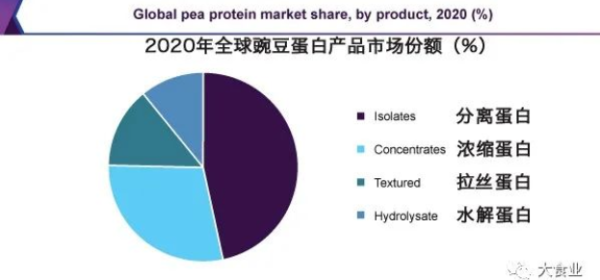The global pea protein market size was valued at USD 213.1 million in 2020. According to a Grand View Research report, the global pea protein market is expected to grow at a compound annual growth rate (CAGR) of 12.7% from 2021 to 2028. Growth is driven by rising product demand owing to rising consumer awareness towards healthy eating and active lifestyles.
In terms of product manufacturing, pea protein continues to increase product innovation with specific functions, including energy balance, weight loss, muscle repair and satiety, and is expected to create a huge market potential. Extracted from a variety of pea varieties, including dried peas, green peas, and chickpeas, this protein is available as protein concentrate, silk protein, and protein isolate.
These products are plant-derived and ideal for consumers opting for a vegan diet. In addition, they are non-toxic, non-allergenic, and easily digestible, and have great potential for applications in beverages, meat substitutes, dietary supplements, and bakery products. The growing importance of flexible diets owing to rising concerns about the heart disease effects associated with red meat consumption is expected to remain a favorable factor for market growth. Furthermore, increasing awareness on the adverse effects of food products containing gluten and lactose is expected to play a key role in boosting the product demand over the forecast year.
In addition, the consumption of protein-fortified functional foods is expected to increase product demand. Rising demand for protein supplements in food products has led to the introduction of new products by food and beverage companies, which is expected to positively impact the market growth. Rising consumption awareness of protein powders that promote bone health and muscle growth is also expected to boost market growth over the forecast period.
Pea protein is under threat from alternative ingredients such as hemp, soy and whey. Rice protein is another ingredient that is gaining prominence globally. When compared nutritionally, both pea and rice proteins have similar protein content (usually 15-22 grams per 100 calories) and are gluten-free, making them allergy-friendly. Rising consumption of whey protein due to various benefits such as muscle growth stimulation and ease of digestion is restraining the usage of pea protein, thereby hindering the market growth.
Dietary supplements lead the market, accounting for over 38% of the global revenue share in 2020. Add pea protein to nutritional syrups, tablets, energy powders, cereal bars and soups for a variety of health benefits such as muscle growth, improved bone health and regulation of blood sugar levels. Rising demand for sports nutrition products owing to rising awareness regarding bone health and muscle improvement is expected to drive the growth of the segment.
The meat substitute market is estimated to witness the fastest CAGR during the period 2021-2028. Growing health problems, such as obesity and diabetes, have led to a shift in vegetarian eating habits. Animal husbandry has a significant impact on the Earth’s natural resources and contributes to global warming to a certain extent. Although this factor has not been quantified, it is believed that awareness of this factor will lead to a shift in global eating habits towards a more vegan diet, thereby contributing to the growth of the meat substitutes market. This trend is expected to promote the incorporation of pea protein as a meat analog.
Pea protein has good textural properties and is expected to facilitate its application in the production of meat products, including lamb, chicken, lamb and beef. However, major consumption of wheat, soybeans, tempeh, tofu and textured vegetable protein as meat substitutes will pose a substitution threat to the market in the coming years.
In 2020, the pea protein isolate product market leads the market, accounting for over 47% of global revenue. Isolates are widely used as nutritional supplements in meat products, energy drinks, fruit mixes and baked goods due to their good emulsifying properties and non-allergenic properties. In developed countries such as the United States, Germany and the United Kingdom, the development of the sports nutrition industry is expected to increase product demand as Cadbury and Amway launch new products in the energy mix field.
The pea protein concentrate segment is estimated to grow at a significant CAGR from 2021 to 2028. Pea protein concentrate has various attributes, such as good emulsification and high digestibility, which drive its use in weight management and dietary supplement applications.
Additionally, these concentrates are gradually incorporated into baked products such as cakes and pastries for good flavor and dry texture. Countries such as Germany and France have a strong manufacturing base for bakery products, and the application of concentrates is expected to increase during the forecast year due to their proximity to equipment manufacturers and easy availability of wheat and rice as raw materials.
Brushed pea protein is used as a texturizer in meat products, baked goods and confectionary products. Additionally, the presence of fiber content in brushed pea protein is expected to facilitate its incorporation in energy powders and juice blends. Rising beef production capacity in China, India and Australia owing to growing domestic demand is expected to boost the use of textured pea protein in the coming years.
The market is highly consolidated. Most of the major players focus on developing indigenous technologies to extract high-quality powders. Additionally, manufacturers may form partnerships with e-commerce portals to ensure the continued availability of their products. However, the high market visibility of soy and milk protein ingredients is expected to force pea counterpart suppliers to develop new strategies to increase their market visibility.

Key Players in the Global Pea Protein Market:
Burcon Nutrascience Corporation (Canada)
Roquette Freres Le Romarin (Roquette, France)
The Scoular Company (Schooler, USA)
DuPont
Cosucra Groupe Warcoing SA (USA)
Nutri-Pea Ltd. (Canada Nutri-Pea Ltd.)
Shandong Jianyuan Group
Sotexpro SA (American Sotexpro Company)
Ingredion, Inc.
Axiom Foods, Inc. (US)
Fenchem Inc. (U.S. subsidiary of Generic Biotech)
Martin & Pleasance (Australia Martin & Pleasance)
The Green Labs LLC
(Source: Grand View Research)
